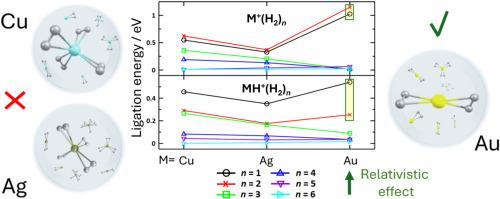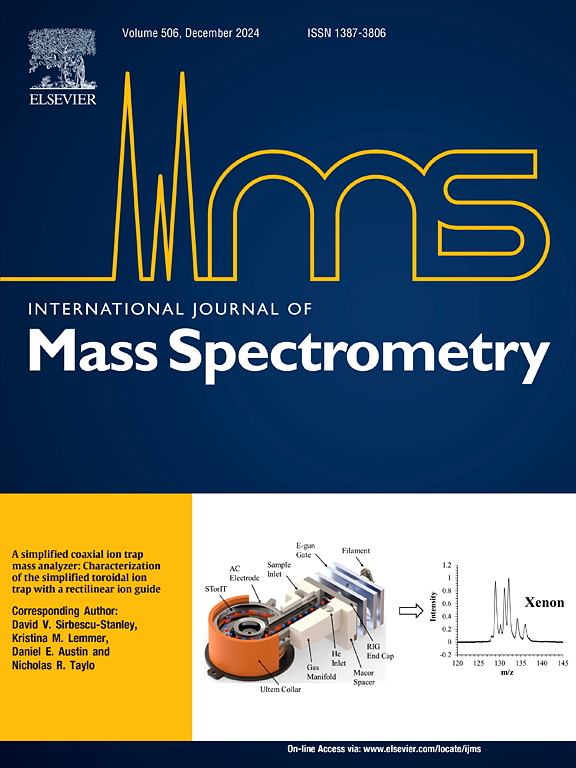在掺杂金属原子的带电He液滴(T<10 K)上用H2加氢原子造金属阳离子(11族):早期阶段、连接能、核心结构、基团变化和相对论效应
IF 1.7
3区 化学
Q3 PHYSICS, ATOMIC, MOLECULAR & CHEMICAL
引用次数: 0
摘要
实验质谱结果表明,电离氦纳米液滴(在T <;10 K)掺杂铸币金属原子M = Cu, Ag或Au,然后暴露于分子氢中,可以提供丰富的单氢化和多重氢化铸币金属阳离子M+(H2)n和MH+(H2)n,其中n高达25甚至更高。在这里,我们探索了这些n = 1-6的连接离子在测量强度中的观测分布所提供的信息,并使用从头算量子化学计算来提取连接能和结构随H2连接增加和元素周期表(M+ = Cu+, Ag+和Au+)的变化的基本见解,并着眼于相对论对随着M+核电荷增加而预期的连接能的贡献。H2加成强度较高的“魔术”数在前5个加成中较为明显,尤其是前2个加成。与第二行连接能相比,第三行连接能有非常大的相对论性增强,特别是对于Au+:前两个H2配体与Au+紧密结合,分别为83%和60%,前两个H2配体与AuH+结合,分别为19%和67%。发现添加第三个H2配体及其他配体的相对论增强基本上可以忽略不计。本文章由计算机程序翻译,如有差异,请以英文原文为准。

Hydrogenating atomic coinage metal cations (group 11) with H2 on charged He droplets (T<10 K) doped with metal Atoms: Early stages, ligation energies, core structures, group variations, and relativistic effects
Experimental mass-spectrometric results are reported which demonstrate that ionized helium nanodroplets (at T < 10 K) doped with the coinage metal atoms M = Cu, Ag or Au, and then exposed to molecular hydrogen, provide an abundance of singly and multiply hydrogenated coinage metal cations M+(H2)n and MH+(H2)n with n up to 25 and beyond. We explore here the information provided by observed distributions in the measured intensities of these ligated ions with n = 1–6 and use ab initio quantum chemical calculations to extract fundamental insights into variations in ligation energies and structures with increasing H2 ligation and going down the Periodic Table (M+ = Cu+, Ag+ and Au+) with an eye on the role of relativistic contributions to the ligation energies expected with the increasing nuclear charge of M+. “Magic” numbers of H2 additions with relatively high intensity are apparent among the first 5, especially the first 2, H2 additions. Very substantial relativistic enhancements of the third over the second-row ligation energies were computed, especially for Au+: 83 % and 60 % respectively, for the first two H2 ligands intimately bonded to Au+, and 19 % and 67 % respectively, for the addition of the first two H2 ligands to AuH+. Relativistic enhancements for the addition of a third H2 ligand and beyond were found to be essentially negligible.
求助全文
通过发布文献求助,成功后即可免费获取论文全文。
去求助
来源期刊
CiteScore
3.60
自引率
5.60%
发文量
145
审稿时长
71 days
期刊介绍:
The journal invites papers that advance the field of mass spectrometry by exploring fundamental aspects of ion processes using both the experimental and theoretical approaches, developing new instrumentation and experimental strategies for chemical analysis using mass spectrometry, developing new computational strategies for data interpretation and integration, reporting new applications of mass spectrometry and hyphenated techniques in biology, chemistry, geology, and physics.
Papers, in which standard mass spectrometry techniques are used for analysis will not be considered.
IJMS publishes full-length articles, short communications, reviews, and feature articles including young scientist features.

 求助内容:
求助内容: 应助结果提醒方式:
应助结果提醒方式:


